BIOL 251 Exam 3 Epidemiology
1/77
There's no tags or description
Looks like no tags are added yet.
Name | Mastery | Learn | Test | Matching | Spaced |
|---|
No study sessions yet.
78 Terms
T/F: Normal microbiata usually cause disease.
F, they do not usually cause disease.
T/F: Normal microbiata do not usually cause disease.
T
T/F: Normal microbiata never cause disease.
F. Normal microbiata usually do not cause disease.
What is symbiosis?
The relationship between 2 organisms where at least one organism benefits
What is commensalism?
One organism benefits, the other is unaffected
Staphylococcus epidermis on the skin is what type of relationship between microbe and host?
Commensalism - One organism benefits, the other is unaffected
Escherichia coli in the intestine is what type of relationship between microbe and host?
Mutualism — Both organisms benefit
What is mutualism?
Both organisms benefit
What is parasitism?
One organism benefits; other is harmed
Pathogenic microorganisms is what type of relationship between microbe and host?
Parasitism — One organism benefits; other is harmed
What are opportunisitic pathogens?
A microorganism that usually/typically does not cause disease in healthy individuals but can cause serious infections in people with weakened immune systems.
What kind of factors affect normal microbiota?
Host factors
What is transient microbiota?
Microorganisms that may be present for several days, weeks, or months, but then disappear.
May or may not cause disease
Microorganisms that may be present for several days, weeks, or months, but then disappear are called
transiet microbiota
Microorganisms that establish a permanent residence are called
normal microbiota
Microorganisms that do not USUALLY cause disease are called
normal microbiota
Microorganisms that may or may not cause disease are called
Transient microbiota
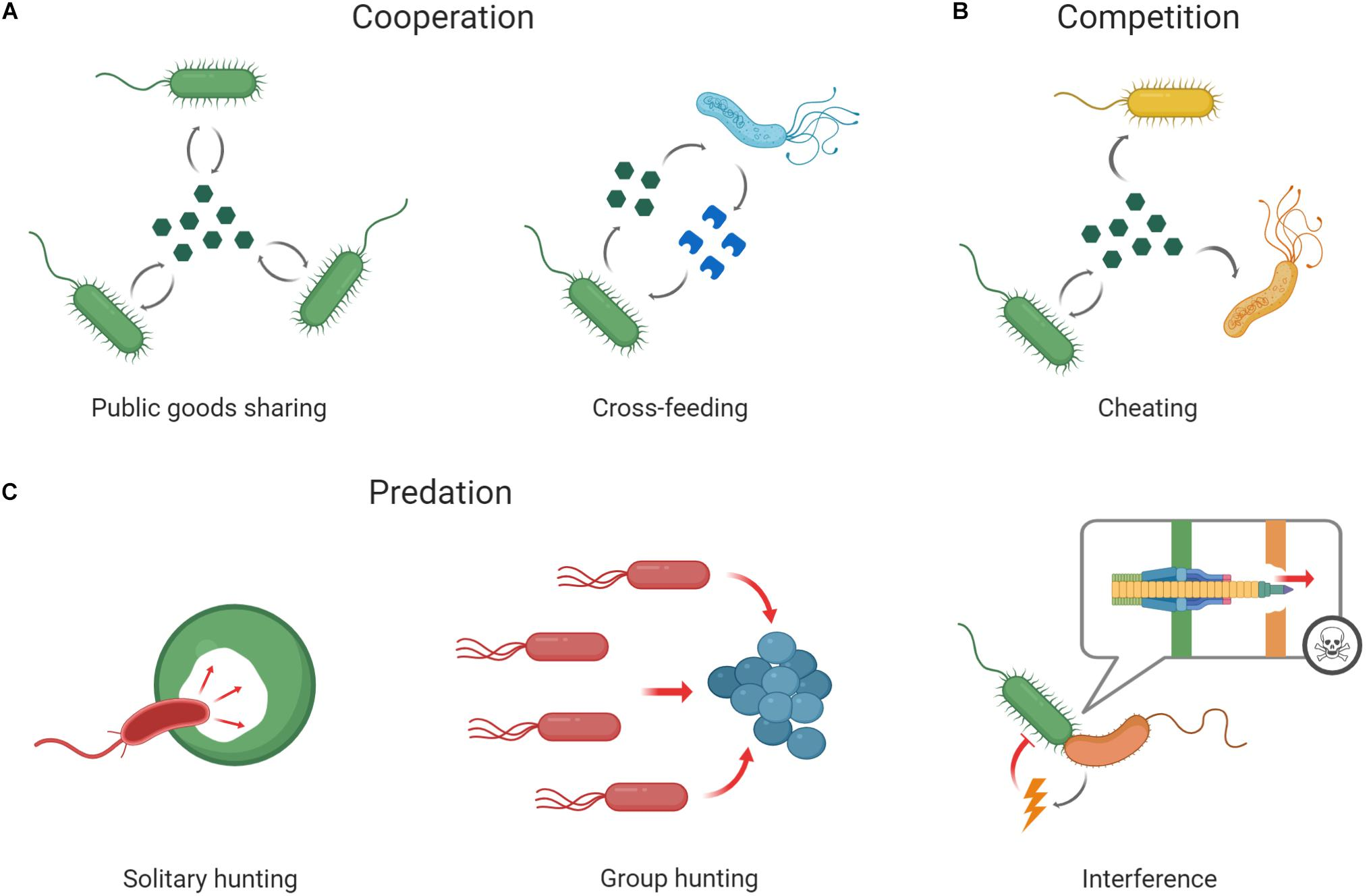
What is microbial antagonism? What is another name for it?
Competitive exclusion — members of the microbiome protect the host from colonization by pathogens
Competition for nutrients and space in the gut microbiome is an example of
microbial antagonism, a benefit of normal microbiota
T/F: When members of the microbiome protect the host from colonization by pathogens, microbial antagonism, this is a benefit of transient microbiota
F, this is a benefit of NORMAL microbiota
E. coli producing bacteriocins in the intestine is an example of
The production of harmful substances, which is microbial antagonism, a benefit of normal microbiota
lactobacilli produce acid and hydrogen peroxide in the vagina, and some members of the microbiome use up oxygen in the intestine, is an example of
Effect conditions (pH, O2 availability) in the surrounding environment which is microbial antagonism, a benefit of normal microbiota
What is an infection? Microorganisms carry out how much of their life cycle in the host body?
Invasion or colonization of the body with pathogenic microorganisms
Microorganisms carry out at least part of their life cycle in the host body
What is disease?
Any change in health caused by an infection
What is pathology?
Scientific study of disease
What is etiology?
causative agent of a disease
What is pathogenesis?
Manner in which a disease develops
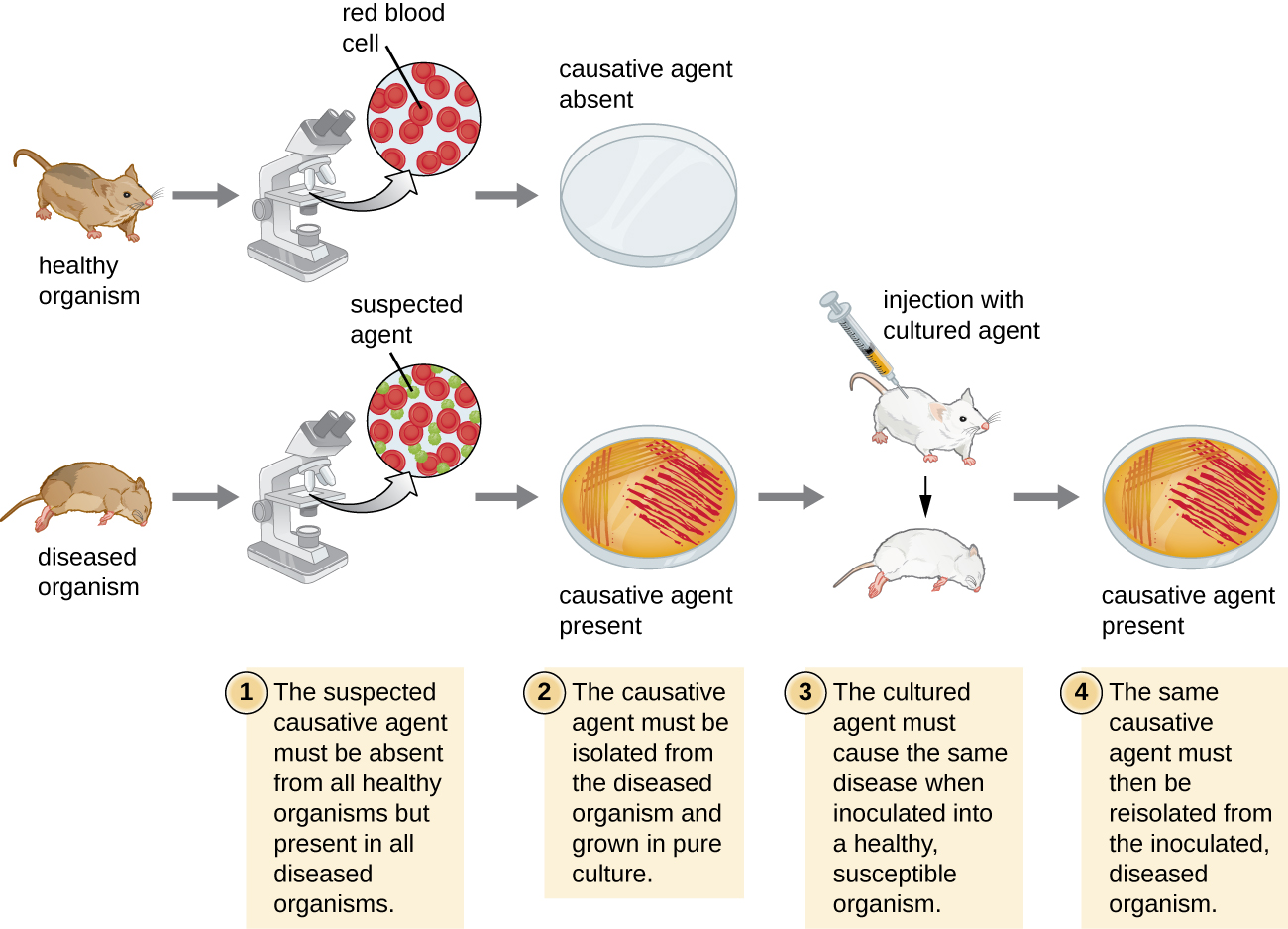
What does Koch’s postulates show? What are its conditions?
Shows that a specific infectious disease is associated with a particular microorganism.
classic steps used to prove that a specific microbe causes a specific disease:
Koch's postulates were devised as general guidelines to identify infectious microbes that could be detected with the available methods and that were demonstrably alive (i.e., capable of independent metabolism, growth, and reproduction).
The same pathogen must be present in every case of the disease
The pathogen must be isolated from the diseased host and grown in pure culture
The pathogen from the pure culture must cause the same disease when inoculated into a healthy, susceptible host.
The pathogen must be isolated from the inoculated animal and must be shown to be the original organism
What are the exceptions to Koch’s postulates?
Culture requirements – may not be possible to grow an organism in pure culture on artificial media (Mycobacterium leprae)
Multiple pathogens may cause the same signs and symptoms (meningitis)
Some pathogens can cause multiple disease conditions (Streptococcus pyogenes)
Lack of a non-human host (HIV)
When classifying infectious disease, what are symptoms?
Symptoms: Subjective changes in body function (things you feel)
When classifying infectious disease, what are signs?
Signs: Objective changes in body function that can be observed and measured
When classifying infectious disease, what is a syndrome?
Syndrome: a specific group of signs and/or symptoms that may always accompany a particular disease
Jason is a 28 year-old man. Yesterday, he started experiencing a headache, fever, nausea, and diarrhea. Which of these are signs of a disease and which are symptoms?
Headache - Symptom
Fever - Sign
Nausea - Symptom
Diarrhea - Sign
What is a communicable disease?
a disease in which an infected person transmits an infectious agent to another person (directly or indirectly)
What is a contagious disease?
highly communicable disease that can spread easily and quickly from one person to another.
What is a noncommunicable disease?
not spread from host to host
Tetanus is an example of what kind of infectious disease?
Noncommunicable disease — not spread from host to host
What is contact transmission?
spread of a disease agent by contact
What is direct contact transmission?
transmission by physical contact with an infected person
Touching
Kissing
Sexual intercourse
What is indirect contact transmission?
transmission by a nonliving object (fomite)
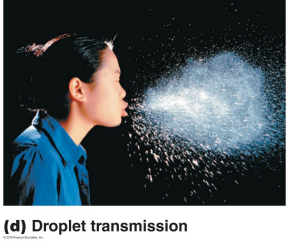
What is droplet transmission?
transmission by droplet nuclei that travel less than 1 meter
What is a vector? What is mechanical and biological transmission?
Vector – animal that carry pathogens from one host to another
Mechanical transmission – passive transport of pathogen on body
Biological transmission – active process
Insect vector bites host and ingests infected blood
Pathogen replicates in the vector
Insect passes pathogen to new host (feces, biting)
What is vehicle transmission?
spread of a disease agent by a medium
What is waterborne transmission, and what type of disease transmission is it?
Waterborne transmission, transmission by contaminated water. It is a type of vehicle transmission.
What is foodborne transmission, and what type of disease transmission is it?
transmission by consumption of contaminated food (improperly cooked, poorly refrigerated, prepared in unsanitary conditions). It is a type of vehicle transmission.
What is airborne transmission, and what type of disease transmission is it?
transmission by droplet nuclei that travel more than 1 meter. It is a type of vehicle transmission.
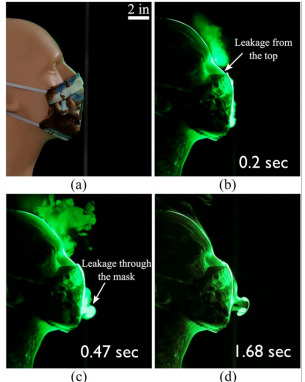
T/F: Masks can catch droplets and some aerosols.
T. Aerosols are slowed and travel shorter distance. Reduces risk of transmission.
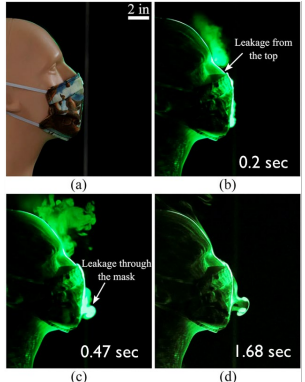
T/F: Masks cannot catch droplets and aerosols.
F. Masks can catch droplets and some aerosols. Aerosols are slowed and travel shorter distance. Reduces risk of transmission.
Jason’s doctor indicates that he likely acquired this infection due to food he had consumed. What type of transmission is this?
Vehicle transmission
What is an acute disease?
a disease that develops rapidly, but lasts only a short time
What is a chronic disease?
a disease that develops slowly, but is often less severe; likely to continue or recur for long periods
What is a latent disease?
a disease in which the causative agent remains inactive for a time, but then becomes active to produce the disease symptoms
What is subclinical disease?
no noticeable illness
What is a local infection?
infection in which the invading microorganisms are confined to a relatively small area of the body
What is a systemic infection?
infection in which the invading microorganisms are spread throughout the body (blood or lymph)
What type of infection is Septicemia? (Septicemia– bacteremia, toxemia, viremia)
a life-threatening systemic infection
What is a primary infection?
acute infection that causes the initial illness
What is a secondary infection?
infection caused by an opportunistic pathogen after the body’s defenses have been weakened by a primary infection
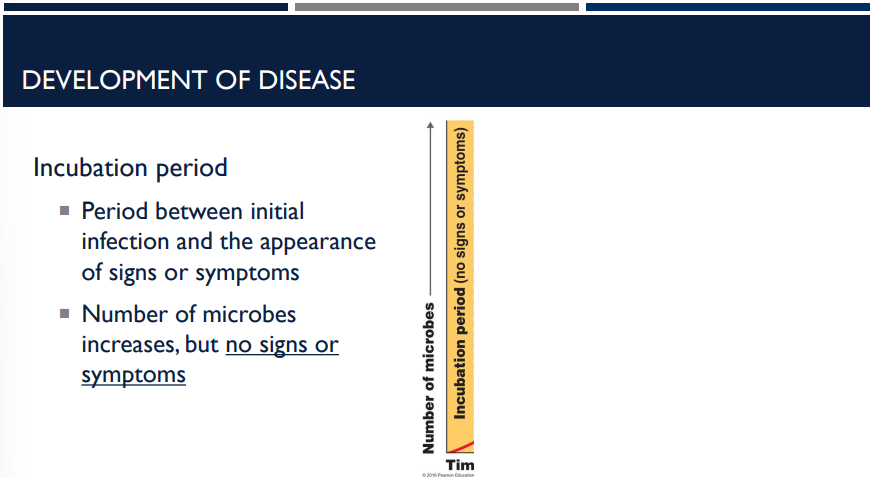
Describe the incubation period in the development of disease.
Period between initial infection and the appearance of signs or symptoms
Number of microbes increases, but no signs or symptoms
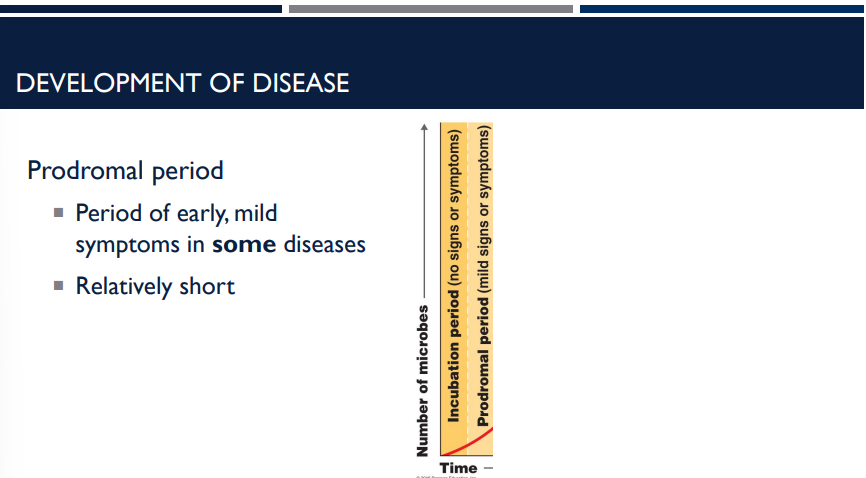
Describe the prodromal period in the development of disease.
Period of early, mild symptoms in some disease
Relatively short
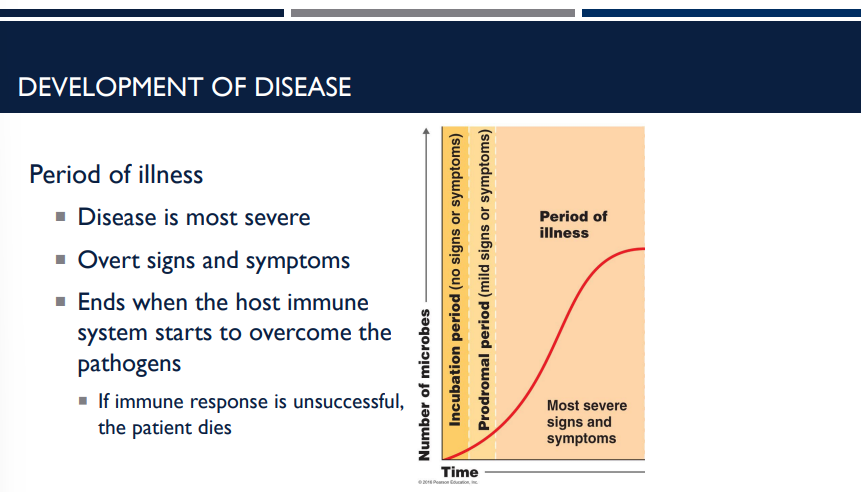
Describe the period of illness in the development of disease.
Disease is most severe
Overt signs and symptoms
Ends when the host immune system starts to overcome the pathogens
If immune response is unsuccessful, the patient dies
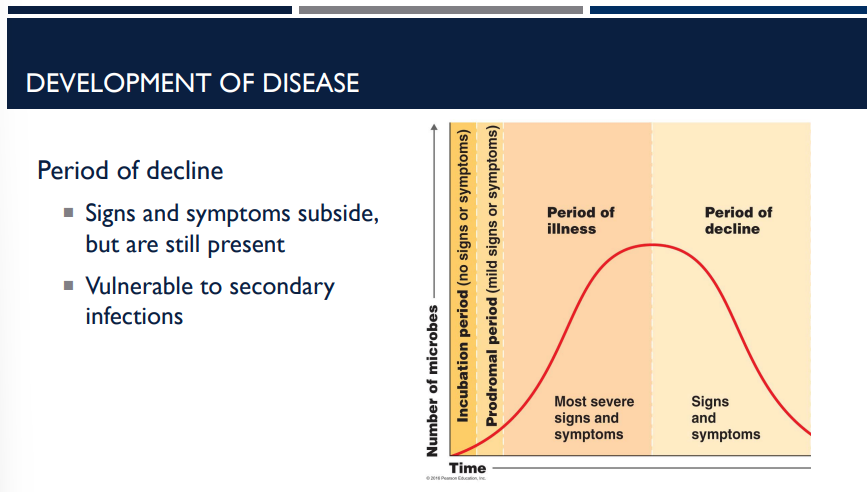
Describe the period of decline in the development of disease.
Signs and symptoms subside, but are still present
Vulnerable to secondary infections
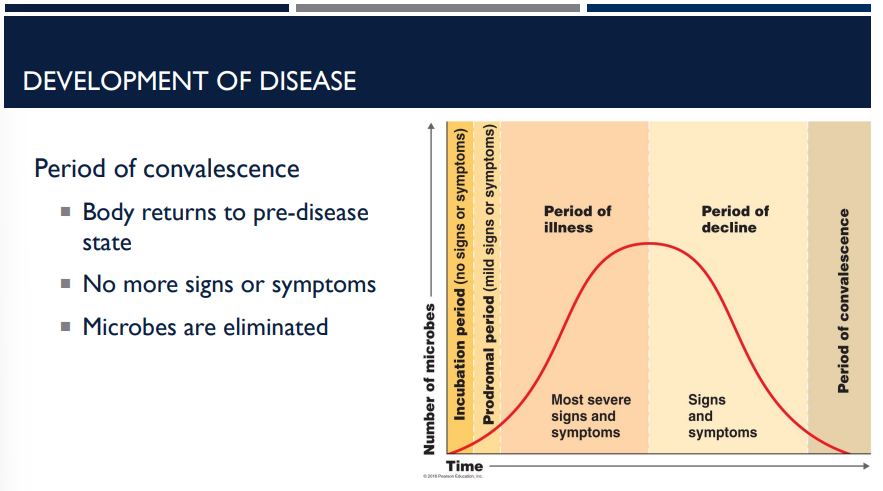
Describe the period of convalescence in the development of disease.
Body returns to pre-disease state
No more signs or symptoms
Microbes are eliminated
Jason’s doctor tells him that he has an infection caused by Salmonella enterica. She indicates that he should start to feel better in a few days, but that he needs to stay hydrated. Which stage of the disease is Jason currently in?
C
Jason is currently in the period of illness, as he is showing the most severe signs and symptoms. As his body's defense combat the infection, he will start to feel better and enter the period of decline.
What is epidemiology?
Study of where and when diseases occur. How diseases are transmitted
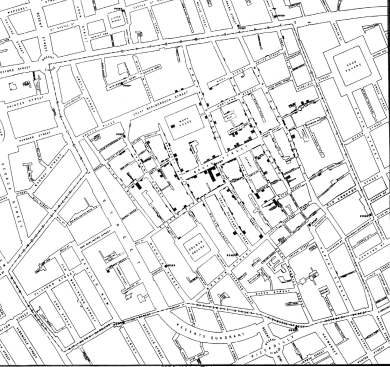
Who is John Snow and why is he important in epidemiology?
Cholera outbreak 1848-1849
Mapped cases
Linked illness to a single water pump
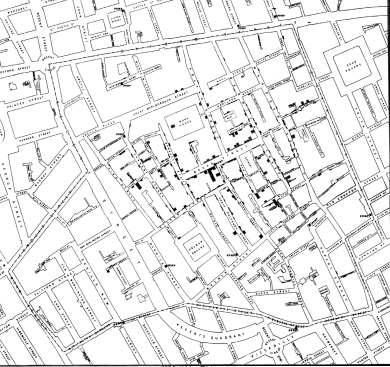
What is descriptive epidemiology?
Collecting all data to describe the occurrence of the disease
Affected individuals
Time and location
Usually retrospective
What is incidence?
Incidence – number of people who develop a disease during a particular time period
New cases of a disease
What is prevalence?
Prevalence – number of people in a population who have a disease at a specified time regardless of when it first appeared
Accounts for old and new cases
What is a sporadic disease?
Sporadic disease – a disease that occurs only occasionally
What is an endemic disease?
Endemic disease – disease that is constantly present in a population
What is an epidemic?
Epidemic – many people in a given geographic area acquire a disease in a short period of time
What is a pandemic?
A worldwide epidemic
What is analytical epidemiology? What are the 2 methods utilized?
Analysis of a particular disease to determine the probable cause
Case-control method – compare a group of ill people to an unaffected group; use statistics to determine which factors may have contributed to illness
Sick vs. not sick
Cohort method – compare a group of people who had contact with the agent of disease and one group that has not
Exposed vs. not exposed
What is experimental epidemiology?
Begins with a hypothesis about a particular disease
Test hypothesis with a group of people
Example: effectiveness of a drug
Testing the effectiveness of a drug is an example of what type of epidemiology?
Experimental epidemiology: Begins with a hypothesis about a particular disease
Describe the case reporting process for diseases.
Healthcare workers report specified diseases to identify the chain of transmission.
Nationally notifiable diseases (must be reported to US Public Health Service)
Including Jason, 261 confirmed Salmonella cases were recorded in 24 states. No single restaurant or restaurant chain was found to be associated with the outbreak. Epidemiologists compared the foods eaten by 53 affected individuals and 53 unaffected individuals in order to determine the source of the infections. What type of study is this? (Select all that apply).
B and E
This is a case-control study. The diets of affected an unaffected individuals were compared to identify the source of the infections. Case-control studies are a type of analytical epidemiology.